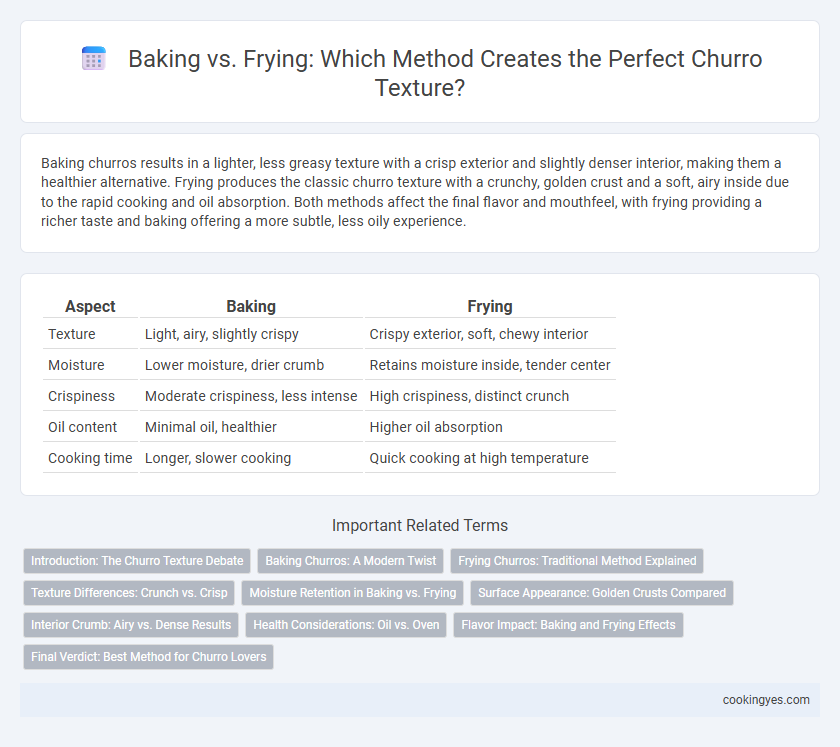Baking churros results in a lighter, less greasy texture with a crisp exterior and slightly denser interior, making them a healthier alternative. Frying produces the classic churro texture with a crunchy, golden crust and a soft, airy inside due to the rapid cooking and oil absorption. Both methods affect the final flavor and mouthfeel, with frying providing a richer taste and baking offering a more subtle, less oily experience.
Table of Comparison
| Aspect | Baking | Frying |
|---|---|---|
| Texture | Light, airy, slightly crispy | Crispy exterior, soft, chewy interior |
| Moisture | Lower moisture, drier crumb | Retains moisture inside, tender center |
| Crispiness | Moderate crispiness, less intense | High crispiness, distinct crunch |
| Oil content | Minimal oil, healthier | Higher oil absorption |
| Cooking time | Longer, slower cooking | Quick cooking at high temperature |
Introduction: The Churro Texture Debate
Baking churros results in a lighter, less greasy texture with a slightly crisp outer layer but lacks the traditional crunch associated with frying. Fried churros develop a golden, crispy exterior and moist, tender interior due to the high-temperature oil cooking process that rapidly seals the dough. Texture preference often depends on whether consumers prioritize health aspects or the classic rich mouthfeel of fried churros.
Baking Churros: A Modern Twist
Baking churros offers a healthier alternative while maintaining a crispy exterior and tender interior by using precise oven temperatures and dough formulations rich in butter and eggs. This method reduces oil absorption, resulting in a lighter texture that appeals to health-conscious consumers without compromising the traditional flavor profile. Innovations in baking techniques and ingredient optimization contribute to achieving the signature ridged shape and golden crust characteristic of churros.
Frying Churros: Traditional Method Explained
Frying churros creates a crispy exterior and a soft, airy interior that defines the traditional texture sought by churro enthusiasts. The high-temperature oil rapidly cooks the dough, forming a golden crust while preserving moisture inside, contrasting with baking which often yields a denser, less crunchy product. Mastering frying techniques such as oil temperature control and dough consistency is essential for achieving authentic churro quality.
Texture Differences: Crunch vs. Crisp
Baked churros offer a lighter, crisp exterior with a more even texture, while fried churros deliver a bolder crunch due to the rapid oil contact creating a thicker, golden crust. The frying process enhances a rich, indulgent mouthfeel with a slightly denser interior, whereas baking results in a less greasy, airier bite. Texture contrasts between baking and frying significantly influence the overall churro experience, catering to preferences for either a delicate crispness or a robust crunch.
Moisture Retention in Baking vs. Frying
Baking churros results in a drier texture with less moisture retention compared to frying, which locks in moisture due to the rapid cooking in hot oil. The frying process creates a crispy exterior while maintaining a tender, moist interior, enhancing the traditional chewy consistency. Baking offers a healthier alternative but may yield a less authentic texture due to reduced moisture content within the churro.
Surface Appearance: Golden Crusts Compared
Churros baked achieve a lighter, less oily surface with a subtle golden crust, whereas frying produces a deeply caramelized, vibrant golden-brown exterior with a distinctive crispness. The Maillard reaction during frying intensifies color and texture, creating a classic crunchy crust compared to the more matte finish of baked churros. Surface oils in fried churros enhance shine and crunch, while baked churros offer a drier, slightly flaky crust appearance.
Interior Crumb: Airy vs. Dense Results
Baking churros produces an interior crumb that is generally denser and less airy compared to frying, which rapidly cooks the dough and traps steam, creating a light, fluffy texture. Frying at high temperatures ensures a crisp exterior while maintaining an airy, hollow crumb typical of traditional churros. Understanding the impact of cooking methods on texture is essential for achieving the desired balance between a crunchy crust and a soft, airy interior.
Health Considerations: Oil vs. Oven
Baking churros significantly reduces oil absorption, resulting in lower calorie content and less unhealthy fat compared to frying, which immerses the dough in hot oil and increases saturated fat intake. Oven-baked churros provide a crisp exterior with a tender interior while limiting trans fat formation that occurs during deep frying. For health-conscious individuals, baked churros offer a lighter alternative without sacrificing the traditional crunchy texture.
Flavor Impact: Baking and Frying Effects
Frying churros creates a crispy, golden exterior with a rich, caramelized flavor due to Maillard reactions and oil absorption, enhancing the classic taste experience. Baking produces a lighter texture with less oiliness, preserving a subtle, doughy flavor but often lacks the deep fried aroma and crunch. The choice between baking and frying significantly influences the churro's flavor profile and texture, catering to preferences for either indulgent crispness or a healthier, softer bite.
Final Verdict: Best Method for Churro Lovers
Frying churros delivers a crisp exterior and tender, airy interior, preserving the traditional texture favored by churro enthusiasts. Baking offers a slightly lighter, less oily alternative but may lack the signature crunch and richness achieved through frying. For churro lovers seeking authentic texture and flavor, frying remains the preferred method.
Baking vs Frying for Churro Texture Infographic

 cookingyes.com
cookingyes.com